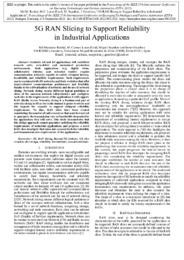Por favor, use este identificador para citar o enlazar este ítem:
https://hdl.handle.net/11000/28503Registro completo de metadatos
| Campo DC | Valor | Lengua/Idioma |
|---|---|---|
| dc.contributor.author | Lucas-Estañ, M. Carmen | - |
| dc.contributor.author | Sepulcre, Miguel | - |
| dc.contributor.author | Gozalvez, Javier | - |
| dc.contributor.other | Departamentos de la UMH::Ingeniería de Comunicaciones | es_ES |
| dc.date.accessioned | 2022-11-30T10:38:16Z | - |
| dc.date.available | 2022-11-30T10:38:16Z | - |
| dc.date.created | 2022-09 | - |
| dc.identifier.uri | https://hdl.handle.net/11000/28503 | - |
| dc.description.abstract | Industry 4.0 and 5.0 applications will contribute towards safer, zero-defect and customized production environments. Such applications (e.g. digital twins, collaborative robotics and extended reality) require communication networks capable to satisfy stringent latency, bandwidth, and reliability requirements. Such requirements can be sustained with 5G networks and their evolution that offer unprecedented communications performance and flexibility thanks to the softwarization of networks and the use of network slicing. Network slicing creates different logical partitions or slices of the common network infrastructure and configures each slice to the requirements of the applications it will support. RAN (Radio Access Network) slicing is a fundamental part of network slicing in 5G as the radio channel is prone to errors and this impacts the capacity to support stringent reliability requirements. To date, RAN slices have been created considering the number of radio resources that must be reserved to guarantee the transmission rate or bandwidth demanded by the applications they will serve. This study demonstrates that this design approach cannot guarantee satisfying the reliability requirements of industrial applications and proposes a novel RAN slice descriptor that takes into account both the reliability and transmission rate requirements of the applications. | es_ES |
| dc.description.sponsorship | This work has been funded by MCIN/AEI/10.13039/ 501100011033 through the project PID2020-115576RB-I00, | - |
| dc.description.sponsorship | FSE funds through the grant PRE2018-084743, by the Generalitat Valenciana through the project CIGE/2021/096 | - |
| dc.description.sponsorship | and by a research grant awarded by the Vicerrectorado de Investigación of the UMH (2022). | - |
| dc.format | application/pdf | es_ES |
| dc.format.extent | 4 | es_ES |
| dc.language.iso | eng | es_ES |
| dc.publisher | IEEE | es_ES |
| dc.relation.ispartof | 2022 IEEE 27th International Conference on Emerging Technologies and Factory Automation (ETFA) | es_ES |
| dc.rights | info:eu-repo/semantics/openAccess | es_ES |
| dc.rights.uri | http://creativecommons.org/licenses/by-nc-nd/4.0/ | * |
| dc.subject | 5G mobile communication | es_ES |
| dc.subject | Shape | es_ES |
| dc.subject | Service robots | es_ES |
| dc.subject | Network slicing | es_ES |
| dc.subject | Bandwidth | es_ES |
| dc.subject | Production | es_ES |
| dc.subject | Reliability engineering | es_ES |
| dc.subject.other | CDU::6 - Ciencias aplicadas::62 - Ingeniería. Tecnología::621 - Ingeniería mecánica en general. Tecnología nuclear. Electrotecnia. Maquinaria::621.3 - Ingeniería eléctrica. Electrotecnia. Telecomunicaciones | es_ES |
| dc.title | 5G RAN Slicing to Support Reliability in Industrial Applications | es_ES |
| dc.type | info:eu-repo/semantics/article | es_ES |
| dc.identifier.doi | 10.1109/ETFA52439.2022.9921528 | - |
| dc.relation.publisherversion | https://doi.org/10.1109/ETFA52439.2022.9921528 | - |

Ver/Abrir:
5G -ETFA2022-RashidLucasSepulcreGozalvez_5G RAN Slicing to Support Reliability (3).pdf
380,59 kB
Adobe PDF
Compartir:
 La licencia se describe como: Atribución-NonComercial-NoDerivada 4.0 Internacional.
La licencia se describe como: Atribución-NonComercial-NoDerivada 4.0 Internacional.
.png)